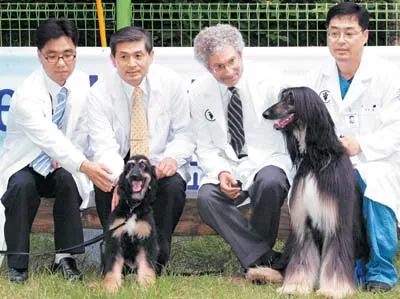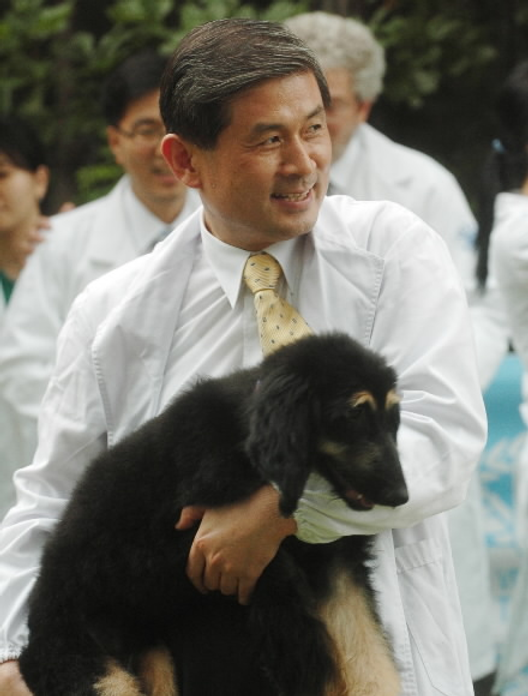
Welcome to the Writing Showcase!
Click the links to see each work!
1. Scicomm Article:
Dog Duplication: The Story of Snuppy
A brief article describing the inception of the famed Snuppy, the first ever cloned dog.
2. Advocacy Project:
A brief article describing the challenges that cloning animals are posed with, not in a scientific sense, but in a PR sense.
Final Scicomm Draft
Dog Duplication: The Story of Snuppy
After several weeks in the making, I present the final draft of my Scicomm Article! Since we were first tasked with researching a particular animal for this assignment, I figured it would be fun (although perhaps slightly challenging) to not focus on a SPECIES of animal, but instead a TYPE of animal. That type being genetic clones of dogs. After researching and writing about Snuppy the Dog, the first ever cloned dog in history, I put together this draft.
Find it here!
https://docs.google.com/document/d/16QMVsPrIK0guv_vHk21-_Pl7GnC9g8QM0p7jbD6FfkQ/edit?usp=sharing
One of the most important things I learned over the course of this scicomm article is the importance of a good, clear narrative. If all the viewer was looking for was cold hard facts, they'd have gone to the original scientific journals! So I realized that talking colloquially and treating it less clinically and more like a story could produce a stronger article.
Advocacy Project
THE MORTALITY OF THE CLONE
In 2005, in a lab at Seoul National University, a little puppy was born. The puppy’s name was Snuppy, and unbeknownst to him, he had already been born once before. Snuppy was a clone of an Afghan Hound named Tai, and despite emerging from a Labrador Retriever, Snuppy was an identical genetic replica of Tai, a purebred Afghan. And while Snuppy spent his days on campus, playing with student researchers on the grass lawns of SNU, a battle over the ethics and morality of his very existence was underway.
In the hotly contested scientific field of cloning, several issues have been argued at length. One of these concerns, which you’ve likely heard of, is the notion that the process of cloning can inflict harm against an organism by increasing the likelihood of diseases and complications. This, coupled alongside the ethical and moral quandaries of cloning represent a significant challenge in how cloning has been and continues to be perceived by the general public. So long as this challenge remains, cloning research and methods will have a harder time both entering the consumer market and advancing to a stage at which it can be effectively used as a means to examine and solve the many genetic and disease-related problems that plague humanity today.
The idea that a clone of an animal might be inherently worse off than its progenitor counterpart is a natural and understandable assumption to make. Having been born of an unnatural process, it's fair to assume that clones, in turn, experience unnatural levels of disease and genetic deformity. After all, there are many documented cases of such defects. Take for example, Judy Jones’ “Cloning may cause health defects,” published in the National Library of Medicine. In it, the researchers found that
“The cloning process seemed to have interfered with the normal genetic functioning of [a] developing calf.”
Yet, consider that this study observed only a sample size of one, which is not a large enough sample size to accurately conclude that cloning is responsible for the harm suffered. Instead, consider this article, “Insights from one thousand cloned dogs,” written by Professor Olof Olsson, detailing results collected from the observations of one thousand cloned dog subjects, a staggeringly large sample size for such an experiment. In it, Olsson and his colleagues find that “[no] abnormalities related to longevity of healthy born clones have been identified,” citing maturation and refinement in cloning techniques and technologies as responsible for the improvement. Given the over two-decade gap between these two articles, it’s safe to assume that the methods used to conduct cloning in 1999 have been fine-tuned to near perfection. Yet, in a survey conducted in 2016, 64% of Americans surveyed stated that they were against cloning, citing their concern for the animal’s health and welfare. Thus, the PR issue remains, even 19 years after the original clone, Dolly the Sheep. It’s likely that today, people are still finding cloning to be a procedure fraught with genetic defects, mutations, and disease. This is especially troubling because, without the support of the general public, cloning technology, methods, and research will have a difficult time gaining traction, funding, and support. To live in a world where cloning is accepted rather than rejected is to live in a world in which cloned organisms can be used to closely study and conquer the most oppressive diseases and conditions that humanity faces, like cancer, Alzheimer’s, or osteoporosis. However, if the public perception of cloning remains stuck in the past which was rife with failure and mishaps, this potential future seems to be farther and farther away. As such, in the interest of advancing cloning science for both animal and human welfare, the way the general public views cloning must change for the better.
Not all progress is linear.
A critic of fastly developing progress in cloning research might point out that though we may not be observing substantial defects in present-day clones, it may not be such smooth sailing for these animals down the road, as they age. If they develop complications at a comparable rate to their natural-born counterparts, there is little cause for concern. But, if it’s proven that, at an advanced age, these clones, or even perhaps reclones (that being a clone of a clone), are more likely to develop disease, the argument that the true problems have yet to show themselves would be given legitimacy. However, that’s only a theory and is not supported by the data currently available today. In fact, even as far back as the first ever cloned animal, Dolly the Sheep, there was no link found between her death at the hands of sheep pulmonary adenomatosis and the fact that she was a clone. Snuppy, the first ever cloned dog, much like Dolly, died of a cancer that researchers believed to be par for the course for Afghan Hounds like him.
How do we begin to change the perception of
cloning in the public eye?
We can start with a global solution, something that can easily be enacted by a governing power or by a large special interest organization. In this case, a team of scientists, if not the same team responsible for “Insights from one thousand cloned dogs.” By following the same test subject dogs well into advanced age, Olsson’s team can not only draw conclusions about the immediate expected lifespan at birth and in early life, but also in the late stages of these dog’s lives. With that information, they could conclude that cloned dogs do in fact have a comparable if not identical lifespan to natural born dogs. By making this conclusion, backed up by their large data set, Olsson’s team could disprove the false notion that clones are at greater risk of shortened lifespans. In terms of “grassroots” solutions available to the general populace, I believe that sincere and well-informed education on cloning and what it could accomplish for the welfare of both people and animals is the best first step that a person can take. To educate one’s peers in turn is to promote the spread of legitimate, factual knowledge on cloning. For example, the team behind Snuppy have stated before that they believe
“the history of both Tai and Snuppy [could] provide potential insights into the development of cancer.”
Familiarizing oneself with knowledge about cloning such as this can allow someone to produce an effective argument in the interest of cloning research.
Ever since the advent of animal cloning, there has also been heavy criticism through
the lens of morality.
As K. Heðinsdóttir wrote in a 2018 journal,
“cloning companion dogs can … be seen as a denial of the animals’ intrinsic value.”
Yet, it is important to note that most criticisms of dog cloning are rooted in applications of companionship and filling a sentimental need, rather than in applications of scientific research. Though dog cloning has since been regrettably commercialized, with the bizarre extent of this being best represented by the exploits of Barbara Streisand, it still maintains numerous scientific applications which serve both humanity and dog-kind heavily enough to justify cloning. After all, it was in this scientific doctrine that the original Snuppy trials were even undertaken. The team behind Snuppy stated
“the ability to clone dogs … should help to determine genetic and environmental contributions to the diverse biological and behavioral traits associated with the many different canine breeds.”
More than that, cloning animals brings us closer to the reality of cloning humans. Although human cloning is an even more hotly contested moral battlefield, the scientific advancements that it makes possible overshadows the moral drawbacks. So, it is here, in the valuable scientific applications of dog cloning, that there exists a case to be made to improve the state of public perception on dog cloning and cloning at large.
In terms of what can be done to improve the way the public perceives cloning, there are two realms of possibility. First is
a global solution,
tasked to far-reaching organizations and authority. Second would be
a grassroots solution,
tasked to the average layman with an interest in improving the perspective on cloning. To begin with a global solution, I find that the power lies in the scientific community, the people most well equipped and well informed to relay to the public the risks, but more importantly, the benefits of cloning research. For instance, the team behind Snuppy notes that dog cloning beyond the sake of preserving a beloved pet, can be used in the conservation of endangered species, to propagate elite working dogs, and to examine hereditary diseases for the sake of curing both canines and humans. The benefits of these applications range from improving the efficiency of dog-reliant industries to finding permanent solutions to heritable disease.
To begin, the team at SNU, or other cloning research teams for that matter, could publish their research in a more accessible format, such as a scicomm article which stresses the potential benefits of cloning. They could also benefit the cause greatly by contacting and getting a spot on the news, domestic or otherwise. Expanding upon a newsclip like this which described Snuppy's birth could be a great platform to tell the masses about the scientific benefits of cloning. Of course, though scientific teams possess the knowledge and methods required to clone animals and consequently vouch for their existence, the layman also has access to the findings of these very same scientists. As such, with a proper platform to speak, a grassroots solution could come in the form of sharing the potential applications of cloning to a mass audience, whether via social media or through spoken protest. One could organize local workshops at community centers and schools, partnering with scientists and veterinarians to ensure accurate information. Collaborating with animal shelters and pet organizations, they could spread awareness at pet shows and science fairs and simultaneously engage with local government representatives, advocating for ethical cloning policies and supporting research funding petitions.
Regardless of how they tackle the problem however, both the global and grassroots solutions must ideally recognize and respond to the question of morality. In their response, they should identify the issue, rather than skirt around it, but also assert that the benefits are an objective forward step for humanity, standing to cure hereditary diseases which have plagued us for generations. Not to diminish the counterargument, but to challenge it, researchers might add that the moral argument against animal cloning is not universally recognized, with not all people believing in an intrinsic value to animals. However, given that dogs occupy a particularly sentimental position in human society, this argument has the potential to come across as cold and clinical, potentially detracting from the overall efficacy. Heðinsdóttir also describes the low efficiency of dog cloning, with many embryos lost to failure in the process. They cite this as a reason to challenge dog cloning, yet this is an argumentative misstep. The regrettably low efficiency of cloning is not an intended facet of the process, but rather an unfortunate error. To improve upon the public image of cloning is to thus improve the resources available to cloning researchers and consequently increase the success rate of future trials. To improve the public image of cloning, it's crucial to secure better resources and funding for researchers, enabling them to refine cloning techniques, leading to higher success rates and fewer failed attempts. Public and private support for advanced technologies and comprehensive training for researchers could mitigate the inefficiencies currently plaguing the process. And as success rates improve, the moral and ethical concerns associated with the high failure rate could diminish, making the practice more acceptable to the public. Additionally, demonstrating tangible benefits, such as curing hereditary diseases, can help shift public perception by highlighting the potential positive impacts on both animals and humans. In turn, this could foster greater support for cloning research, creating a positive feedback loop where improved success rates and public acceptance reinforce each other.
TIME recognized Snuppy as "Invention of the Year" in 2005, a shining beacon of what the future held in terms of cloning. The potential for cloning to bring about great change is obvious and I hope that the excitement that Snuppy drove into the scientific community becomes a long standing reoccurrence. Before that though, the world must be as receptive to cloning as it was at the time of Snuppy's birth and we must seek to accept these technologies as powerful forces for change.









Works Cited
Jones, Judy. "Cloning may cause health defects." BMJ: British Medical Journal 318.7193 (1999): 1230. https://www.ncbi.nlm.nih.gov/pmc/articles/PMC1115633/
Olsson, P. O., Jeong, Y. W., Jeong, Y., Kang, M., Park, G. B., Choi, E., Kim, S., Hossein, M. S., Son, Y.-B., & Hwang, W. S. (2022). Insights from one thousand cloned dogs. Scientific Reports, 12(1). https://drive.google.com/file/d/1VO_JT8aXqyNjHVM6-Tg5VHQe9u1R4V69/view?usp=sharing
Ibtisham, F., et al. "Animal cloning drawbacks an-overview." J. Dairy Vet. Anim. Res 3.4 (2016): 3-7. https://www.researchgate.net/profile/Fahar-Ibtisham/publication/308415153_Animal_Cloning_Drawbacks_An-Overview/links/580971fa08ae1c98c252624d/Animal-Cloning-Drawbacks-An-Overview.pdf
Roslin Institute. (2008, February 27). Dolly’s final illness. https://web.archive.org/web/20080227144956/http://www.roslin.ac.uk/publicInterest/DollyFinalIilness.php
Kim, M.J., Oh, H.J., Kim, G.A. et al. Birth of clones of the world’s first cloned dog. Sci Rep 7, 15235 (2017). https://doi.org/10.1038/s41598-017-15328-2
Heðinsdóttir, K., et al. "Can friends be copied? Ethical aspects of cloning dogs as companion animals." Journal of Agricultural and Environmental Ethics 31 (2018): 17-29. https://link.springer.com/article/10.1007/s10806-018-9706-y#Sec12
Lee, Byeong Chun, et al. "Dogs cloned from adult somatic cells." Nature 436.7051 (2005): 641-641. https://www.nature.com/articles/436641a
Kim, M. J., et al. "Lessons learned from cloning dogs." Reproduction in domestic animals 47 (2012): 115-119. https://onlinelibrary.wiley.com/doi/full/10.1111/j.1439-0531.2012.02064.xcasa_token=YgyJbLwK82oAAAAA%3Af9w4gXs0EU7WGwQ7dJnBZAklSXMH-us_Ouqbp1aVybg8kYcNoEmWMZapyBB8rHEYRtDkqdHhBWjUqAlM



